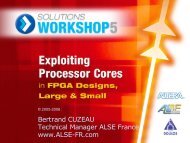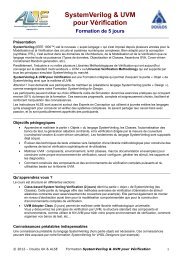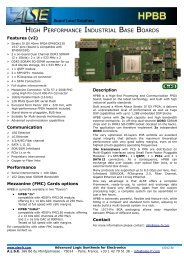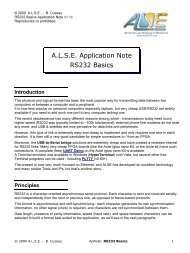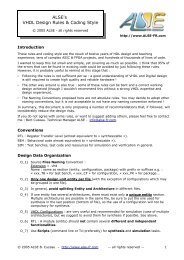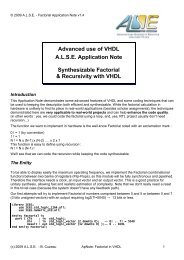FPGA Anti-Copy Protection System - ALSE
FPGA Anti-Copy Protection System - ALSE
FPGA Anti-Copy Protection System - ALSE
You also want an ePaper? Increase the reach of your titles
YUMPU automatically turns print PDFs into web optimized ePapers that Google loves.
I. INTRODUCTION<br />
Inadequate design security is emerging as one of the single largest threats to the intellectualproperty-based<br />
economies of the modern world. Consequences of inadequate design security can<br />
include lost revenue due to counterfeit products and increased liability due to product tampering.<br />
<strong>Copy</strong> protection issues do not concern ASIC designers, but most SRAM-based <strong>FPGA</strong> designers<br />
must keep in mind that the precious bitstream can very easily be cloned and reused by<br />
unauthorized parties. Some <strong>FPGA</strong> vendors offer now specific families that implement protection<br />
schemes, but we'll see that any <strong>FPGA</strong> can benefit from the simple solution developed by <strong>ALSE</strong>.<br />
<strong>ALSE</strong>'s solutions<br />
As a response to this copy protection challenge, <strong>ALSE</strong> introduced two highly cost-effective<br />
fixed-secret authentication schemes based on a cheap and secure authentication device. In<br />
both solutions, the authentication is achieved through a variable challenge-response mechanism<br />
and user secret keys. Communication with the host is achieved through a single wire interface,<br />
in order to avoid consuming precious I/Os, and to simplify the board layout.<br />
The solution is based on :<br />
1. A small footprint cryptography & verification engine inside the <strong>FPGA</strong> (~380 Logic Cells).<br />
2. An external authentication component which embed is the same crypto engine.<br />
One version of the <strong>Protection</strong> kit is based on Intersil components (ISL 6296 / ISL 9206), the<br />
other version can be fitted in any secure and inexpensive CPLD, like Altera's MaxII<br />
EPM240. For quantities, such a device should cost in the 1 € range.<br />
3. A one-wire communication protocol allowing the <strong>FPGA</strong> to challenge the external device<br />
with an interrogation code and retrieve the response to be compared with the value<br />
calculated internally.<br />
Thanks to the small <strong>FPGA</strong> area required, the one-wire communication, and the low cost and small<br />
size of the authentication engine, adding security to just any <strong>FPGA</strong> design is both easy and<br />
affordable, even if the decision to protect the design comes as an after-thought.<br />
Due to these features, it is quite easy to add this anti-copy scheme even to a design that wasn't<br />
planned initially to implement it. A small PCB area and one or two I/Os available on the <strong>FPGA</strong> are<br />
sufficient to secure a design.<br />
Important : any <strong>FPGA</strong> can be protected with our <strong>Anti</strong>-<strong>Copy</strong> Kit. The customer must specify, at time<br />
of purchase, the unique device family to protect.<br />
Any processor-based system could potentially be protected by our <strong>Anti</strong>-<strong>Copy</strong> Max II device, but<br />
<strong>ALSE</strong> will not provide the internal algorithm, as would be necessary to implement the protection in<br />
software. As a consequence, this <strong>Anti</strong>-<strong>Copy</strong> Kit is not usable for processor protection schemes,<br />
except when the processor is embedded in an Altera <strong>FPGA</strong> (SOPC).<br />
An advantage of the CPLD protection (as opposed to using a dedicated device) is that the CPLD<br />
can be reprogrammed, thus providing the possibility to update or change the protection scheme at<br />
any time on an existing board without any hardware change.<br />
Commercial model<br />
<strong>ALSE</strong> offers a single price for protecting a single but complete <strong>FPGA</strong> family for as many projects<br />
as desired within the same company, using a unique set of encryption keys.<br />
The generation of other sets for different <strong>FPGA</strong> families or different encryption keys is a (very<br />
affordable) option.<br />
Advantages<br />
This <strong>Anti</strong>-<strong>Copy</strong> <strong>Protection</strong> Kit offers many advantages :<br />
➢ Several authentication device are possible with no risk of obsolescence (CPLD).<br />
➢ Since no source code is available, the risk of leaks within the company can be easily controlled.<br />
Furthermore, there is no specific tool or development system to purchase.<br />
© <strong>ALSE</strong> Introduction do <strong>ALSE</strong>'s <strong>Anti</strong>-<strong>Copy</strong> <strong>Protection</strong> 2



